Abstract
Adipocytes contain adenosine receptors, termed A1 receptors, which inhibit lipolysis by decreasing adenylate cyclase activity. The inhibition of lipolysis by adenosine agonists in vivo acutely suppresses the plasma concentrations of free fatty acids (FFA) and triglycerides. We have found that infusions of the adenosine receptor agonist phenylisopropyladenosine (PIA) initially decreases plasma FFA concentrations; however, with prolonged exposure (6 d), rats become very tolerant to the effects of the drug. Adipocytes isolated from epididymal fat pads from PIA-infused rats have altered lipolytic responses. When lipolysis is stimulated with a relatively high concentration of isoproterenol (10(-7) M), PIA does not inhibit lipolysis in adipocytes from the infused animals. However, PIA inhibits isoproterenol-stimulated cyclic AMP (cAMP) accumulation in adipocytes from the infused rats although with decreased sensitivity compared with controls. The explanation for the impaired antilipolytic effect appears to be due to the fact that isoproterenol-stimulated cAMP accumulation is markedly increased in cells from infused rats. Indeed, basal lipolysis and lipolysis stimulated with lower concentrations of isoproterenol (10(-9), 10(-8) M) are effectively inhibited by PIA. cAMP accumulation is greatly increased in adipocytes from infused rats when stimulated by isoproterenol, ACTH, and forskolin. The results have some striking analogies to changes induced in nerve cells by prolonged exposure to narcotics. These data suggest that tolerance to PIA develops in adipocytes as a consequence of enhanced cAMP accumulation.
Full text
PDF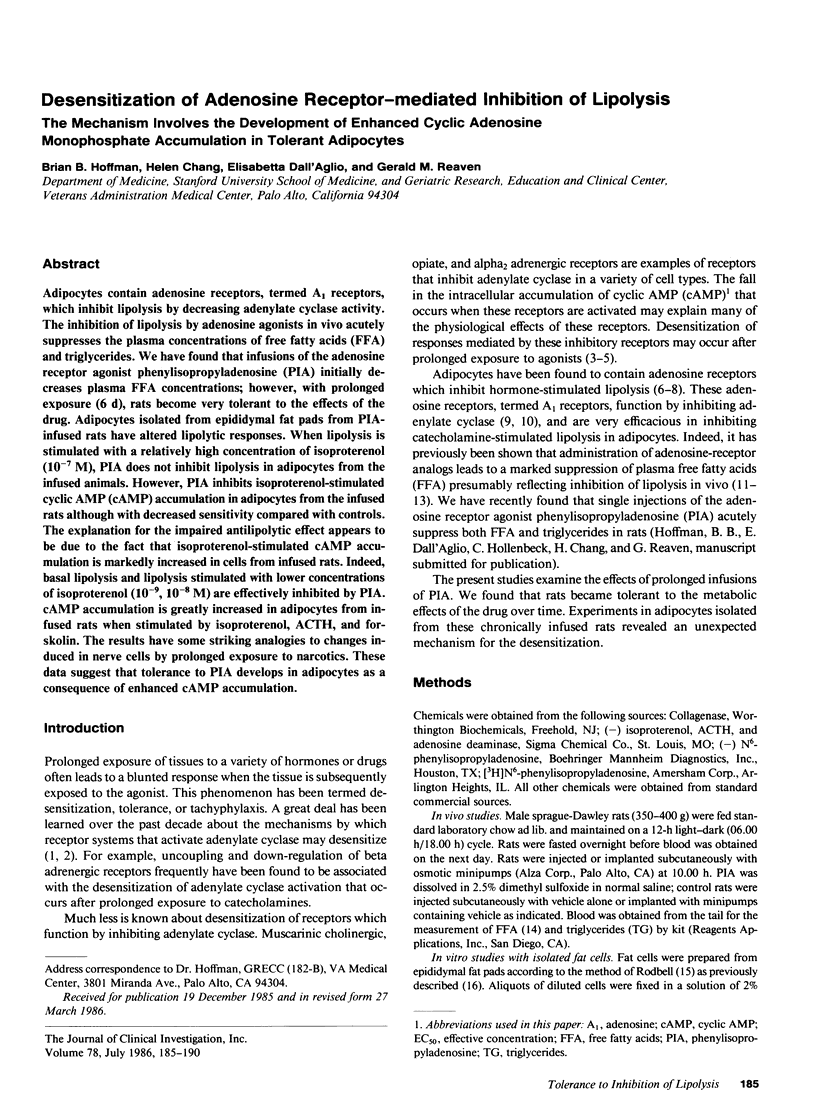
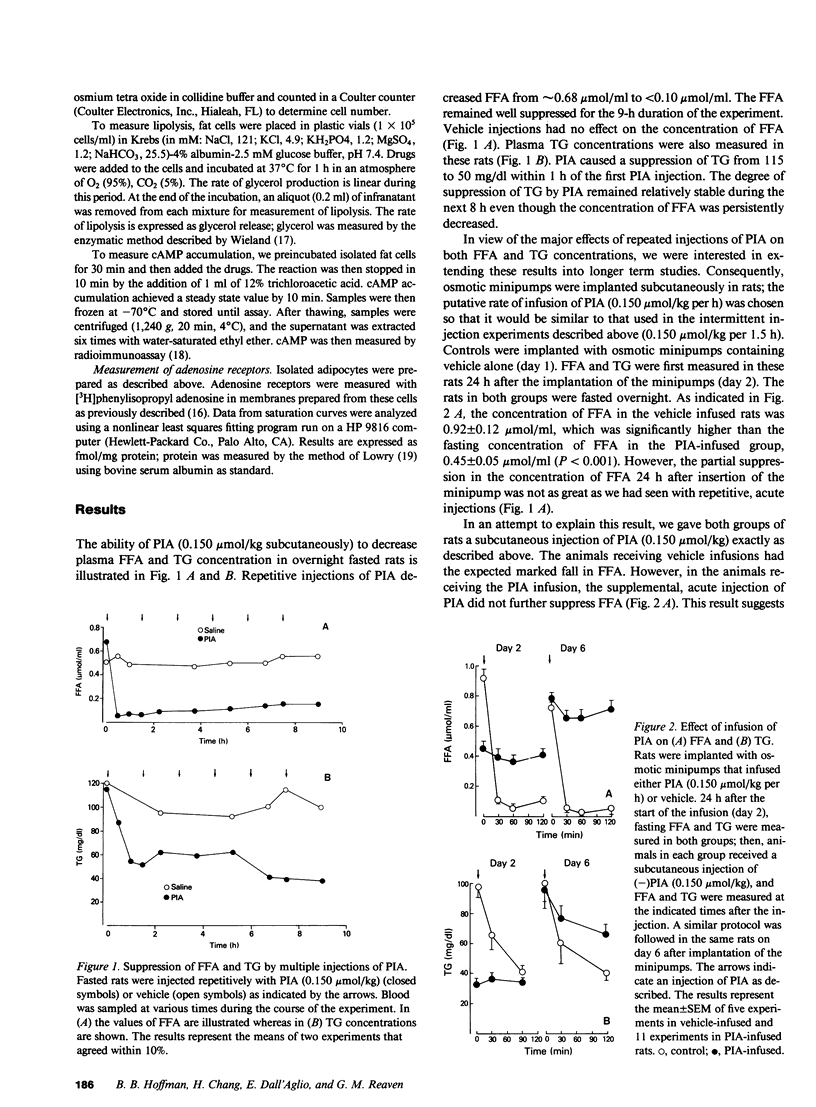
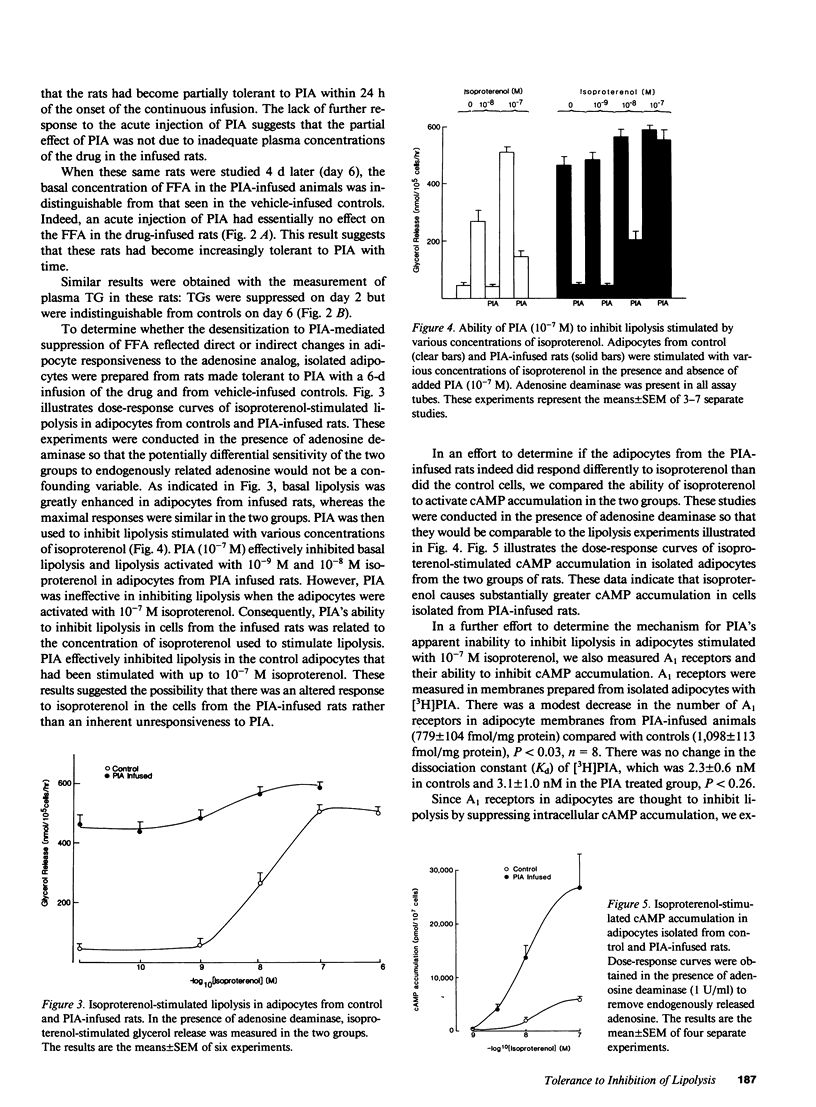

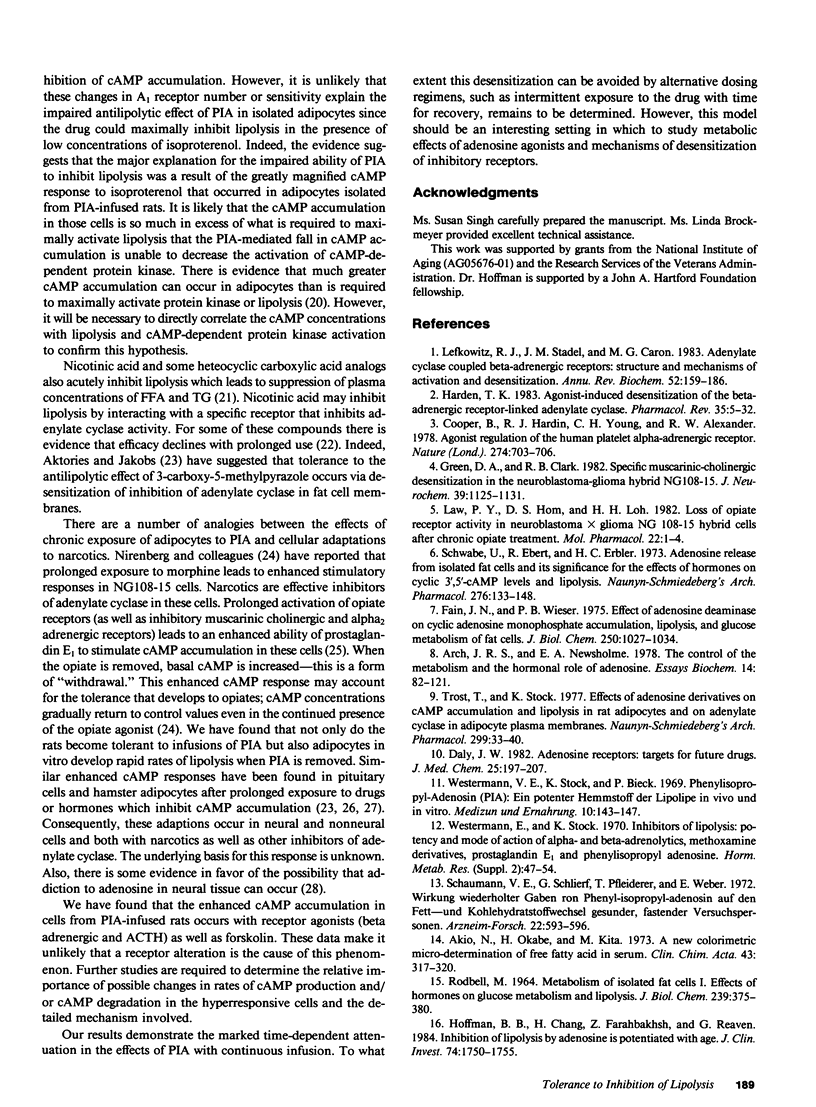
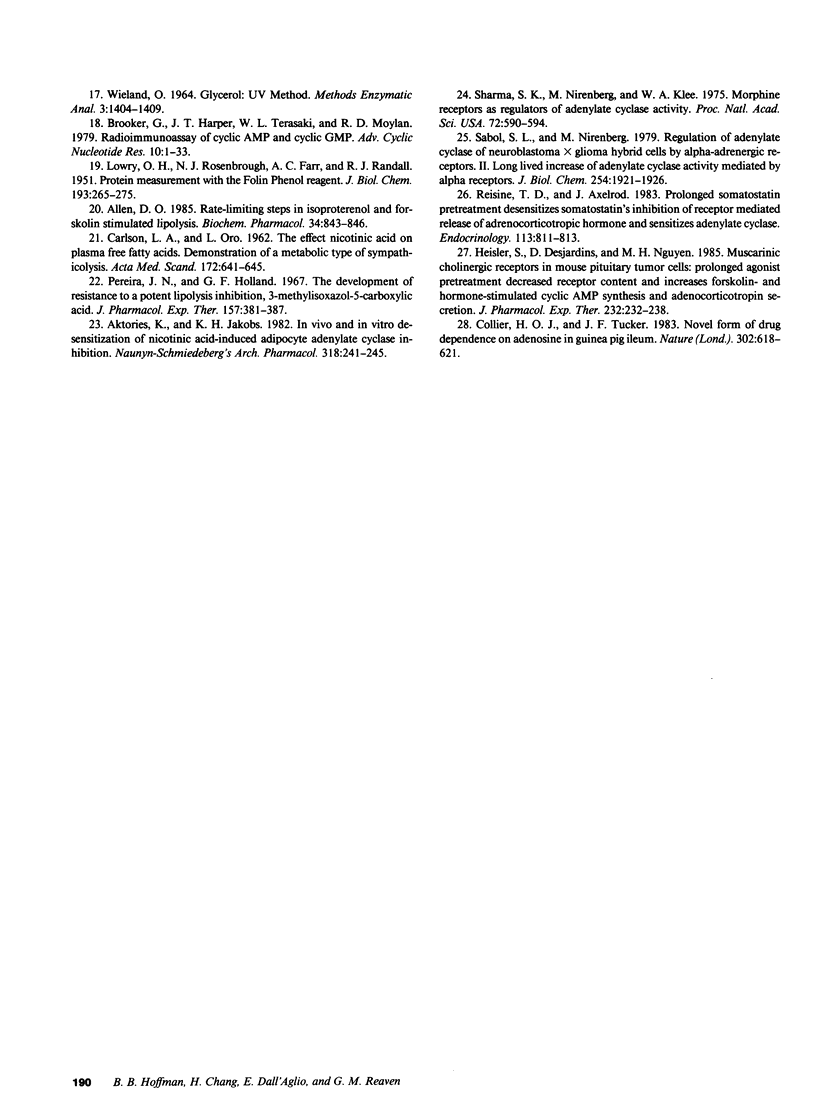
Selected References
These references are in PubMed. This may not be the complete list of references from this article.
- Aktories K., Jakobs K. H. In vivo and in vitro desensitization of nicotinic acid-induced adipocyte adenylate cyclase inhibition. Naunyn Schmiedebergs Arch Pharmacol. 1982 Feb;318(3):241–245. doi: 10.1007/BF00500486. [DOI] [PubMed] [Google Scholar]
- Allen D. O. Rate-limiting steps in isoproterenol and forskolin stimulated lipolysis. Biochem Pharmacol. 1985 Mar 15;34(6):843–846. doi: 10.1016/0006-2952(85)90765-8. [DOI] [PubMed] [Google Scholar]
- Arch J. R., Newsholme E. A. The control of the metabolism and the hormonal role of adenosine. Essays Biochem. 1978;14:82–123. [PubMed] [Google Scholar]
- Brooker G., Harper J. F., Terasaki W. L., Moylan R. D. Radioimmunoassay of cyclic AMP and cyclic GMP. Adv Cyclic Nucleotide Res. 1979;10:1–33. [PubMed] [Google Scholar]
- CARLSON L. A., ORO L. The effect of nicotinic acid on the plasma free fatty acid; demonstration of a metabolic type of sympathicolysis. Acta Med Scand. 1962 Dec;172:641–645. doi: 10.1111/j.0954-6820.1962.tb07203.x. [DOI] [PubMed] [Google Scholar]
- Collier H. O., Tucker J. F. Novel form of drug-dependence--on adenosine in guinea pig ileum. Nature. 1983 Apr 14;302(5909):618–621. doi: 10.1038/302618a0. [DOI] [PubMed] [Google Scholar]
- Cooper B., Handin R. I., Young L. H., Alexander R. W. Agonist regulation of the human platelet alpha-adrenergic receptor. Nature. 1978 Aug 17;274(5672):703–706. doi: 10.1038/274703a0. [DOI] [PubMed] [Google Scholar]
- Daly J. W. Adenosine receptors: targets for future drugs. J Med Chem. 1982 Mar;25(3):197–207. doi: 10.1021/jm00345a001. [DOI] [PubMed] [Google Scholar]
- Fain J. N., Wieser P. B. Effects of adenosine deaminase on cyclic adenosine monophosphate accumulation, lipolysis, and glucose metabolism of fat cells. J Biol Chem. 1975 Feb 10;250(3):1027–1034. [PubMed] [Google Scholar]
- Green D. A., Clark R. B. Specific muscarinic-cholinergic desensitization in the neuroblastoma-glioma hybrid NG108-15. J Neurochem. 1982 Oct;39(4):1125–1131. doi: 10.1111/j.1471-4159.1982.tb11505.x. [DOI] [PubMed] [Google Scholar]
- Harden T. K. Agonist-induced desensitization of the beta-adrenergic receptor-linked adenylate cyclase. Pharmacol Rev. 1983 Mar;35(1):5–32. [PubMed] [Google Scholar]
- Heisler S., Desjardins D., Nguyen M. H. Muscarinic cholinergic receptors in mouse pituitary tumor cells: prolonged agonist pretreatment decreases receptor content and increases forskolin- and hormone-stimulated cyclic AMP synthesis and adrenocorticotropin secretion. J Pharmacol Exp Ther. 1985 Jan;232(1):232–238. [PubMed] [Google Scholar]
- Hoffman B. B., Chang H., Farahbakhsh Z., Reaven G. Inhibition of lipolysis by adenosine is potentiated with age. J Clin Invest. 1984 Nov;74(5):1750–1755. doi: 10.1172/JCI111593. [DOI] [PMC free article] [PubMed] [Google Scholar]
- LOWRY O. H., ROSEBROUGH N. J., FARR A. L., RANDALL R. J. Protein measurement with the Folin phenol reagent. J Biol Chem. 1951 Nov;193(1):265–275. [PubMed] [Google Scholar]
- Law P. Y., Hom D. S., Loh H. H. Loss of opiate receptor activity in neuroblastoma X glioma NG108-15 hybrid cells after chronic opiate treatment. A multiple-step process. Mol Pharmacol. 1982 Jul;22(1):1–4. [PubMed] [Google Scholar]
- Lefkowitz R. J., Stadel J. M., Caron M. G. Adenylate cyclase-coupled beta-adrenergic receptors: structure and mechanisms of activation and desensitization. Annu Rev Biochem. 1983;52:159–186. doi: 10.1146/annurev.bi.52.070183.001111. [DOI] [PubMed] [Google Scholar]
- Noma A., Okabe H., Kita M. A new colorimetric micro-determination of free fatty acids in serum. Clin Chim Acta. 1973 Feb 12;43(3):317–320. doi: 10.1016/0009-8981(73)90468-3. [DOI] [PubMed] [Google Scholar]
- Pereira J. N., Holland G. F. The development of resistance to a potent lipolysis inhibitor, 3-methylisoxazole-5-carboxylic acid. J Pharmacol Exp Ther. 1967 Aug;157(2):381–387. [PubMed] [Google Scholar]
- RODBELL M. METABOLISM OF ISOLATED FAT CELLS. I. EFFECTS OF HORMONES ON GLUCOSE METABOLISM AND LIPOLYSIS. J Biol Chem. 1964 Feb;239:375–380. [PubMed] [Google Scholar]
- Reisine T., Axelrod J. Prolonged somatostatin pretreatment desensitizes somatostatin's inhibition of receptor-mediated release of adrenocorticotropin hormone and sensitizes adenylate cyclase. Endocrinology. 1983 Aug;113(2):811–813. doi: 10.1210/endo-113-2-811. [DOI] [PubMed] [Google Scholar]
- Sabol S. L., Nirenberg M. Regulation of adenylate cyclase of neuroblastoma x glioma hybrid cells by alpha-adrenergic receptors. II. Long lived increase of adenylate cyclase activity mediated by alpha receptors. J Biol Chem. 1979 Mar 25;254(6):1921–1926. [PubMed] [Google Scholar]
- Schaumann E., Schlierf G., Pfleiderer T., Weber E. Wirkung wiederholter Gaben von Phenyl-isopropyl-adenosin auf den Fett- und Kohlehydratstoffwechsel gesunder, fastender Versuchspersonen. Arzneimittelforschung. 1972 Mar;22(3):593–596. [PubMed] [Google Scholar]
- Schwabe U., Ebert R., Erbler H. C. Adenosine release from isolated fat cells and its significance for the effects of hormones on cyclic 3',5'-AMP levels and lipolysis. Naunyn Schmiedebergs Arch Pharmacol. 1973;276(2):133–148. doi: 10.1007/BF00501186. [DOI] [PubMed] [Google Scholar]
- Sharma S. K., Nirenberg M., Klee W. A. Morphine receptors as regulators of adenylate cyclase activity. Proc Natl Acad Sci U S A. 1975 Feb;72(2):590–594. doi: 10.1073/pnas.72.2.590. [DOI] [PMC free article] [PubMed] [Google Scholar]
- Trost T., Stock K. Effects of adenosine derivatives on cAMP accumulation and lipolysis in rat adipocytes and on adenylate cyclase in adipocyte plasma membranes. Naunyn Schmiedebergs Arch Pharmacol. 1977 Aug;299(1):33–40. doi: 10.1007/BF00508634. [DOI] [PubMed] [Google Scholar]
- Westermann E., Stock K. Inhibitors of lipolysis: potency and mode of action of - and -adrenolytics, methoxamine derivatives, prostaglandin E 1 and phenylisopropyl adenosine. Horm Metab Res. 1970;2(Suppl):47–54. [PubMed] [Google Scholar]


